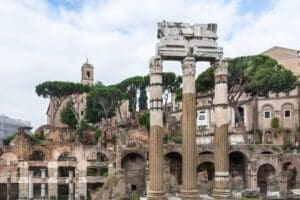
Discovering the Legends of Venus, Rome’s Goddess of Love
(originally written on mysteriousadventurestours.com)
The goddess Venus is a figure shrouded in mystery and legend. From her origins as an Italic fertility deity to her role in the Roman pantheon, to the numerous monuments dedicated to her around Rome, it’s clear that she was a highly revered figure. In this blog post, we’ll explore some of the legends and folklore surrounding Venus and discover where in Rome you can find places dedicated to the goddess.
 VENUS’ ORIGINS AND ROLE IN ROMAN MYTHOLOGY
VENUS’ ORIGINS AND ROLE IN ROMAN MYTHOLOGY
In Roman mythology, Venus was the goddess of love and fertility. She was believed to be the daughter of Jupiter and Dione, with some sources also claiming her mother was Juno or even Saturn. According to legend, she was born from the seafoam and fully clothed when she emerged from it. Her cult originated amongst Italic tribes who worshiped her as a fertility goddess known as Venilia or Genetillia before being adopted by the Romans who renamed her Venus. Throughout history she has been linked with culture, sex appeal, and beauty, becoming one of the most iconic figures in Roman mythology.
 VENUS’ IMPACT ON ANCIENT ROME
VENUS’ IMPACT ON ANCIENT ROME
The impact that Venus had on Ancient Rome is evident from the many places across Rome dedicated to honoring her name. Most famous amongst these is perhaps the Temple of Venus Genetrix located near the Forum of Caesar which was built by Julius Caesar himself in 46 BC as part of his Forum Iulium complex. The temple took its name from its dedication to his family’s ancestral goddess – ‘Genetrix’ meaning mother – while also serving as a symbol for Caesar’s victory over Pompey at Pharsalus four years prior. This temple exemplified how important Venus was considered by both Caesar himself and all those living in Ancient Rome at this time.
 OTHER TEMPLES DEDICATED TO VENUS
OTHER TEMPLES DEDICATED TO VENUS
Aside from this temple, there were many other shrines dedicated to honoring Venus across Ancient Rome including temples located at Vesta (which dates back to 495 BC) and at Hadrian’s Villa (built during Emperor Hadrian’s reign). A few centuries later another shrine was erected on Palatine Hill by Emperor Elagabalus in 221 AD which reportedly housed a statue of Aphrodite-Venus standing on a chariot pulled by two white horses while holding doves in her hands (although no trace remains today). Today visitors can still visit many of these sites such as those on Palatine Hill or Vesta where they can get a glimpse into what life must have been like during ancient times when Venus reigned supreme over Roman mythology!
When it comes to exploring Roman mythology, few gods stir up quite as much mystery and intrigue as that of Venus – goddess of love and fertility!
From her origins as an Italic deity to Julius Caesar erecting temples dedicated specifically to honoring her – it’s clear that she held an incredibly important place within Ancient Roman society. For anyone looking for a glimpse into what life may have been like during this period then visiting any one (or more!)of these sites would be sure to provide them with an insight into this mysterious time!
Explore A Darker Side Of Rome
Rome is not only full of rich history and stunning/iconic views, but it also has a wicked and dark side that adds to the lore of this incredible city. Read more about the weird/wicked travel of Rome in my article: Weird Traveler- Rome.


 VENUS’ IMPACT ON ANCIENT ROME
VENUS’ IMPACT ON ANCIENT ROME OTHER TEMPLES DEDICATED TO VENUS
OTHER TEMPLES DEDICATED TO VENUS
